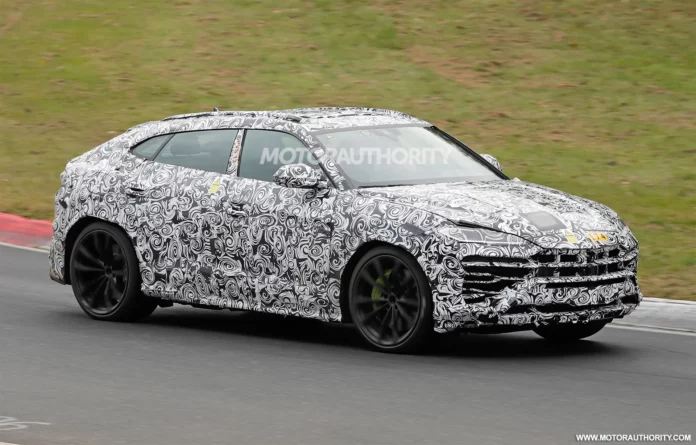Lamborghini
In the ever-evolving automotive landscape, iconic supercar brands are not immune to the sweeping changes brought about by environmental concerns and technological advancements. Lamborghini, known for its roaring V-12s and V-10s, is undergoing a monumental shift in its approach to car manufacturing.
With the recent launch of the Huracán Sterrato, the era of pure internal combustion engines from the Raging Bull has reached its pinnacle. However, this isn’t the end, but a new beginning, as Lamborghini sets its sights on electrification, ensuring both sustainability and performance for its loyal clientele.
Electrification
Key Points
- Lamborghini is moving towards a more electric future, with all future models being electrified.
- The first plug-in hybrid from Lamborghini is the Revuelto, which will be followed by a plug-in hybrid Urus and a plug-in hybrid successor to the Huracán.
- The electrified Urus is due in the first half of 2024.
- The Urus plug-in hybrid is expected to have a unique front fascia, a new hood without vents, and slimmer headlights.
- It is likely that the Urus plug-in hybrid will use the same powertrain as the 2024 Porsche Cayenne Turbo E-Hybrid, which delivers a peak of 729 hp.
- The Huracán successor is expected to use the same plug-in hybrid powertrain as the Urus, meaning the end of the V-10 engine.




Plug-in hybrid
- End of Pure Internal Combustion Era: Lamborghini launched the Huracán Sterrato as its last car powered solely by an internal combustion engine. Future models will all have some level of electrification.
- Revuelto: The first plug-in hybrid from Lamborghini is the Revuelto, which is meant to replace the Aventador. It features a V-12 engine and three electric motors, offering a combined power of 1,000 horsepower.
- Electrified Urus: A plug-in hybrid version of the Urus SUV is expected to launch in the first half of 2024. Prototypes have been spotted and are distinguishable by a unique front fascia, a new hood devoid of vents, slimmer headlights, and a likely charging port cover on the driver’s side rear fender. This model is expected to have a powertrain that combines the current twin-turbocharged 4.0-liter V-8 with an electric motor, similar to setups in the Audi Q7, Bentley Bentayga, Porsche Cayenne, and Volkswagen Touareg.
- Performance Expectations: The Urus plug-in hybrid is expected to surpass the 657-hp peak rating of the current Urus range, and it should also offer a small electric-only range.
- Huracán Successor: The successor to the Lamborghini Huracán is also expected to be a plug-in hybrid, marking the end of Lamborghini models powered solely by gasoline engines.
- Matrix LED Design: The electrified Urus is likely to feature Volkswagen Group’s next-generation matrix LED design for its headlights, promising better brightness and precision.
V-8
Lamborghini’s move aligns with the broader automotive industry’s shift towards cleaner and more sustainable forms of propulsion, while still focusing on delivering high-performance supercars.
Pros of Lamborghini’s electrification:
- Reduced emissions: Electric and plug-in hybrid vehicles produce fewer emissions than gasoline-powered vehicles, which is beneficial for the environment.
- Improved performance: Electric motors can provide instant torque, which can improve acceleration and handling.
- Increased efficiency: Electric and plug-in hybrid vehicles are more efficient than gasoline-powered vehicles, which means they can travel further on a single charge.
- Reduced costs: Electric and plug-in hybrid vehicles can save owners money on fuel and maintenance costs.
- Government incentives: Many governments offer incentives to purchase electric and plug-in hybrid vehicles, such as tax breaks and rebates.
Cons of Lamborghini’s electrification:
- Higher upfront cost: Electric and plug-in hybrid vehicles are typically more expensive to purchase than gasoline-powered vehicles.
- Limited range: Electric vehicles have a limited range on a single charge, which can be a limitation for long-distance trips.
- Lack of charging infrastructure: There is still a lack of charging infrastructure in many areas, which can make it difficult to charge electric and plug-in hybrid vehicles.
- Performance concerns: Some Lamborghini enthusiasts are concerned that electric and plug-in hybrid vehicles will not be as exciting or performant as gasoline-powered vehicles.
Conclusion
Lamborghini’s foray into electrification showcases a strategic blend of retaining its brand’s essence while adapting to contemporary demands. The introduction of models like the Revuelto and the anticipated plug-in hybrid Urus underscores the brand’s commitment to innovation without compromising on performance. As the sun sets on the era of gas-powered Lamborghinis, it simultaneously heralds the dawn of a new, electrified age for the iconic Italian automaker. The future, it seems, is both green and powerful.





































